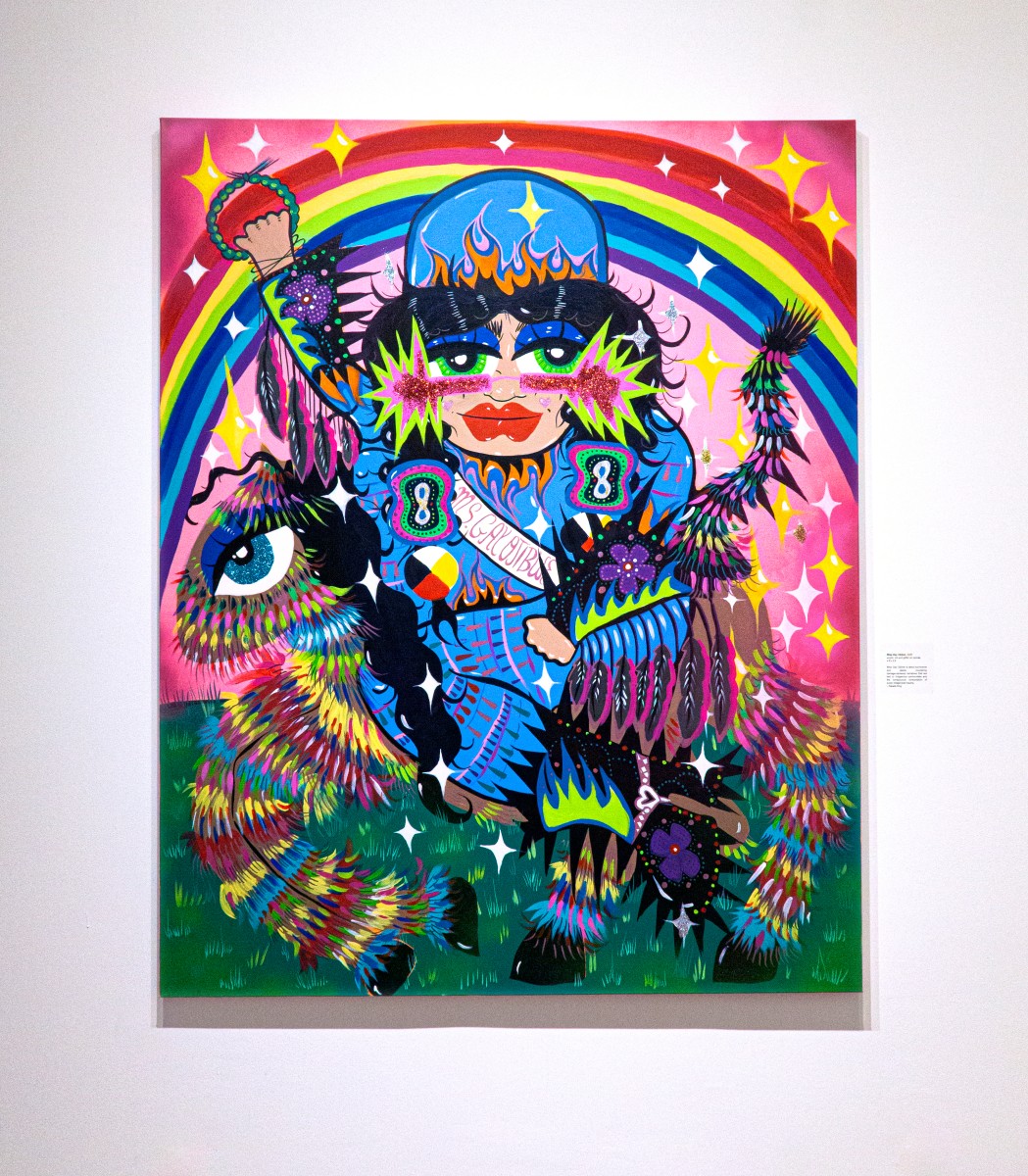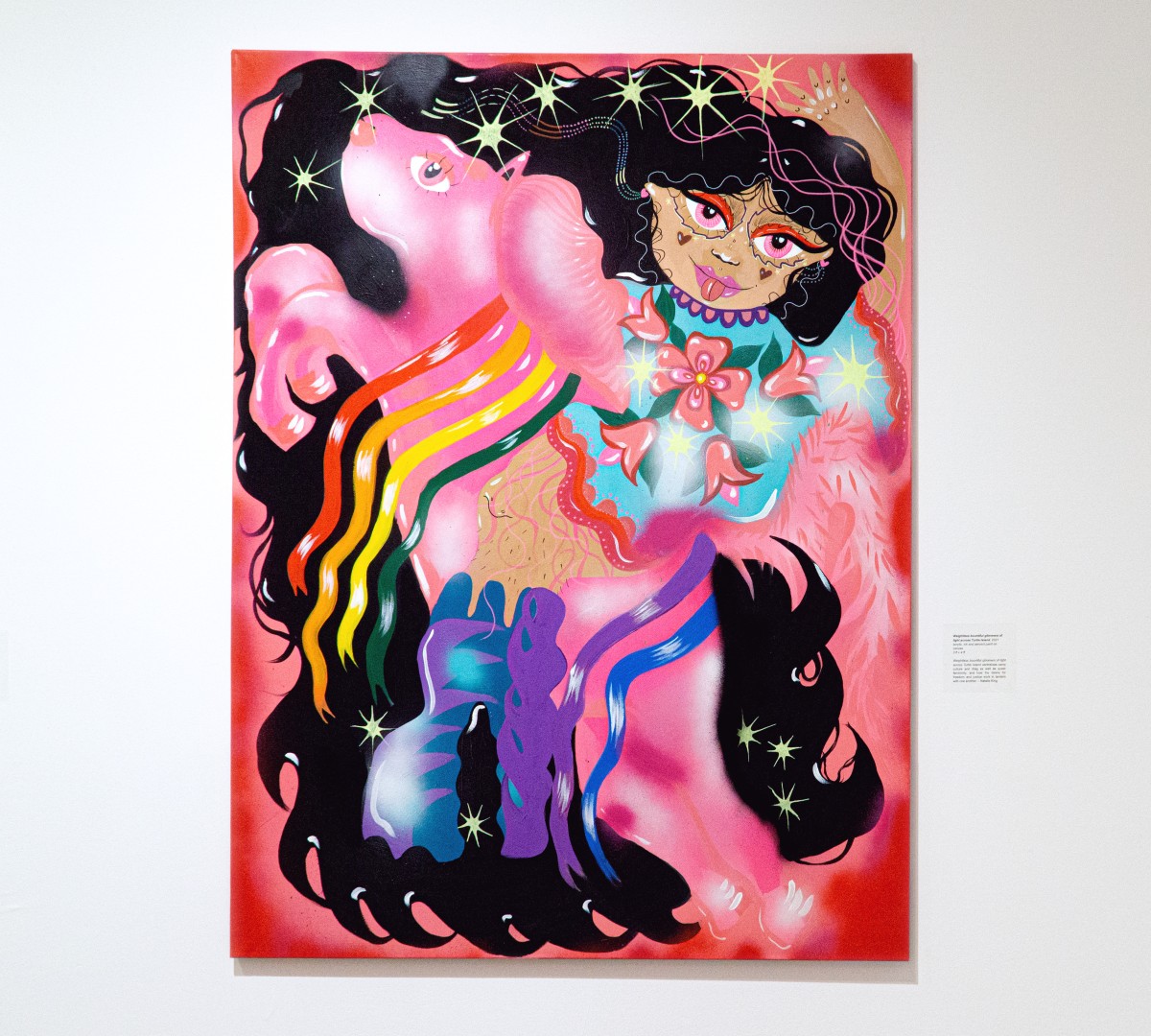Bursting with Love
Natalie King puts queer Indigenous pride on display in PAGEANT, on view now through April 16 at Centre[3]. We caught up with the artist to learn more about it.

Natalie King, PAGEANT, installation view. Photo by Alex Borghesan. Image courtesy of Centre[3].
Effervescent and exuberant, a sense of unabashed joy emanates from Natalie King’s work on view now through April 16 at Centre[3]. Named by NOW Magazine as an emerging artist to watch, King’s overall practice is interdisciplinary, spanning video, painting, sculpture and installation as well as community engagement, curation and arts administration. King is both queer and Anishinaabe − a member of Timiskaming First Nation, currently based in tsí Tkaròn:to.
There’s playful humour sprinkled into King’s work, but underlying it is an earnest desire to share transformative narratives about queer Indigenous peoples. King is positioned firmly from a “critical, anti-colonial, non-oppressive and future-bound perspective”, exploring the interconnectedness between queer femme and Indigenous identities. With a dizzying colour palette and whimsical queer femmes figures in her work like Miss Gay Ojibwe, King imagines an abundantly joyful state of being, in the face of trauma, violence and loss. Guest curator Ryan Rice writes of the exhibition, “Centred on facets of representation and presence, […] PAGEANT is about inhabiting and indulging an outwardly fluid status of one’s realities and identities put on glorious display.”
For a deeper understanding, we connected with King for more insights into her work and the exhibition.
AGOinsider: You’ve described your paintings in the exhibition as “capturing survivance and desire, countering damage-centred narratives tied to Indigenous communities and the conspicuous consumption of queer Indigenous trauma.” Can you elaborate on what you mean by this, especially with the word “survivance”?
King: “Survivance” is a term coined by Gerald Vizenor, but I am mostly referencing Eve Tuck. Tuck speaks about the idea of a “moratorium on damage-centred narratives in our communities”, by this Tuck is referencing the ideas of Indigenous people’s narratives being tied to trauma, and how this is problematic and misleading, and that does not reflect the true variations and experiences in our vast and varied communities, families, and relations. There is so much joy, beauty, silliness, humour and love in our communities, and this is generally overlooked to portray a people that are centred in trauma, which is entirely false.
It's really about resistance and denying the commodification of trauma and violence. It's about transforming our relations and the things that we all as agents of colonialism and oppression (willingly and unwillingly) partake in. I’m trying to get the viewer to entangle themselves in the project of colonialism, but also searching and daydreaming about a future that is self-determined, through a queer lens that is focused on joy and pleasure.
AGOinsider: Who is Miss Gay Ojibwe? Can you describe the symbolism in the painting, Miss Gay Ojibwe (2020) and how it relates to the other works in the exhibition?
King: She’s mostly tongue-in-cheek, an alter ego of sorts. She represents Native humour in a way too – it’s like she’s teasing or poking fun at art or the idea of what people’s expectations or perceptions of Native art are, or art based around one’s identity, and she’s poking fun at everyone that views her because she loves them so much.
I’m also reflecting on Native art canon queer alter egos, such as Kent Monkman’s Miss Chief Eagle Testickle or Adrian Stimson’s Buffalo Boy. Miss Gay Ojibwe isn’t necessarily a real living person, but a personification of many or many different and overlapping ideas of reclamation and the transformational nature of drag, a continuation of that, coming from a young urban queer Anishinaabe woman’s perspective. It’s also a play-on-words, much like the artists’ alter egos I mentioned earlier. She’s inspired by Lisa Frank illustrations, and she’s also somewhat a personification of my childhood dreams and aspirations, a dream or longing for queer Indigenous representation.
AGOinsider: The figures in your work have a whimsical quality to them, represented with exaggerated facial features, long, intertwining tresses, and an exuberant colour palette. How did you develop this aesthetic? Are there other creatives – contemporary or otherwise – that you turned to for inspiration?
King: I want my work to be as open and accessible to folks as possible. I love the idea of things that glow or sparkle or pop. I started out making works around the fact that LGBTQ2S+ people(s) are leaders, and I wanted to highlight that we deserve respect and power over ourselves and that we are such an important part of our communities. We transform not only ideas and thoughts about gender roles and family but also, we are strong, insightful and beautiful. I wanted that to be the sort of, highlight or the takeaway. So, I would make these large-scale figures made from foam core and hang them from the ceiling or stand them up sort of like queer superheroes or cut-outs from movie theatres. What I wanted to speak somewhat to youth specifically was a sense of something to turn to or see yourself in. Now that my work has expanded and changed a bit, I think in some ways I’m doing that too but also, I want people to experience joy when they look at my work, so I use colours and shapes and tones and expressions I find fun, exciting or unexpected.
AGOinsider: You bring a lot of yourself and your experiences to this work as a queer and Indigenous person. Is there a painting included in the exhibition or elsewhere in your practice that represents you best? Can you describe why?
King: I would say Boundless glimmers of light across Turtle Island (2021).
AGOinsider: What feels most urgent for you to express to audiences through your work?
King: I would like people to leave with a sense of world-building, pleasure-centred resistance, and joy. I’m really interested in that transformative aspect − the work I do is engaging with issues of representation, social interaction, social systems, and material access. Using art as a connection with culture, with land and with each other, is important, and being vulnerable or being willing to learn in public is challenging, especially in relation to investigating the effects colonization has had on my identity and being willing to share this. I make this work, especially for my queer Indigenous kin in mind. I know this sentiment is shared often, but I don’t think people fully understand how important this is, how impactful this can be for your spirit.
PAGEANT: Natalie King is on view at Centre[3] through April 16. Get up-to-date with the artful happenings in Hamilton this spring with our stories on Michèle Pearson Clarke’s Muscle Memory at the Art Gallery of Hamilton and Tim Whiten’s Elemental: Ethereal at the McMaster Museum of Art.
Are you an AGOinsider yet? If not, sign up to have stories like these delivered straight to your inbox every week.



